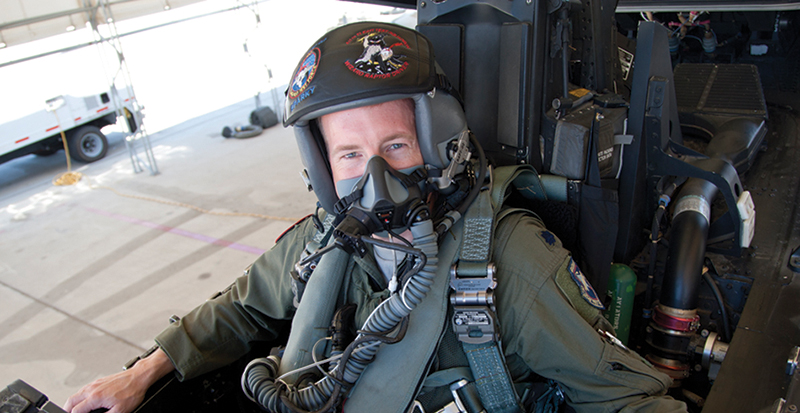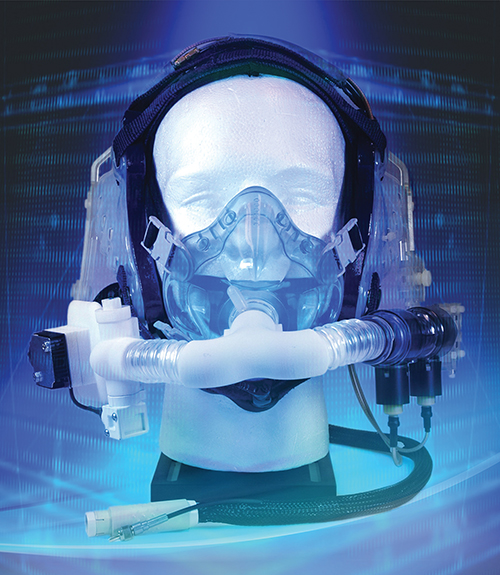
Miniaturized, Portable Sensors Monitor Metabolic Health
NASA Technology
On Earth, gravity might weigh you down, but it also builds you up. For astronauts working in space for long durations, the weightless environment can cause a host of detrimental health effects, such as a loss of bone and muscle mass. Another side effect is cardiovascular deconditioning.
One way of gauging cardiovascular conditioning is by analyzing a person’s metabolic rate, or the amount of energy he or she expends in a given period, and one of the key ways this is done is by analyzing the amount of oxygen a person consumes and carbon dioxide they produce during respiration.
The body’s ability to utilize oxygen—a critical component in energy production—is, in addition to genetics, dependent on a person’s level of physical fitness. A strong heart can pump oxygenated blood faster, and healthier muscle tissue can absorb the element more efficiently.
Analyzing metabolic rates traditionally requires industry-standard metabolic carts. The machines are bulky and heavy, consisting of a computer system, monitor, and breathing tubes all assembled on a push cart. Wanting a more portable and lightweight device to use on the International Space Station (ISS), in 2002 NASA Glenn Research Center partnered with Case Western University and the Cleveland Clinic to develop what in 2006 became the Portable Unit for Metabolic Analysis (PUMA).
PUMA offers most of the functionality of a metabolic cart but condensed into a portable, wearable system. Each unit consists of headgear that supports a mask connected to sensors that measure oxygen and carbon dioxide partial pressure, volume flow rate, heart rate, and gas pressure and temperature. The oxygen and carbon dioxide sensors are located on the left side of the mask, the flow sensors on the right, and all are connected optically and electrically to an electronics box—powered by a camcorder battery—that fits into a small, wearable pack. This computer performs the basic calculations before sending the data wirelessly and in real time to a remote computer that stores and displays the metabolic data.
“We’re happy with what we developed,” says Glenn engineer Dan Dietrich. “And what makes PUMA stand out from other similar units that have been developed is the quality of the sensors. Aside from gauging a person’s metabolic rate, they’re sensitive enough to be used to monitor specific health conditions.”
Technology Transfer
Cleveland-based Orbital Research Inc. had previously worked with NASA to develop an electrocardiogram harness with dry electrodes, and during that stint the company heard about PUMA. Convinced of its potential applications in athletic training and patient monitoring in hospitals, the firm began talks with the Agency on commercializing the technology. But Orbital Research expanded its plan to include military applications when the company realized that the Naval Air Systems Command (NAVAIR) was requesting proposals to assess the health of pilots during flight. Hence, Orbital Research proposed monitoring the exhaled oxygen and carbon dioxide levels of NAVAIR’s pilots with an improved metabolic sensor system.
The reason? Military pilots, who rely on oxygen masks when flying at high altitudes, are at risk of experiencing hypoxia—a condition where the body is deprived of an adequate oxygen supply. Pilots can experience a range of symptoms, including headaches, fatigue, shortness of breath, and nausea. In the worst-case scenario, they can pass out. By monitoring oxygen and carbon dioxide levels, Orbital would attempt to determine the onset of the potentially deadly condition. With both Earth and air-based concepts to pursue, Orbital Research entered into a Space Act Agreement with NASA in 2009.
For fighter pilots to be able to wear a metabolic sensor system, all of the components needed to be made smaller and lighter. For one, this meant developing a more portable electronics box. It also meant developing even lighter sensors that could be retrofitted onto a pilot’s oxygen mask. The PUMA sensors and the casing weighed a pound, which was too heavy. “If you’re a pilot and you’re pulling 9 Gs and you have a sensor package weighing half a pound in your facemask, that’s equivalent to four and a half pounds of weight that’s going to be yanking on your neck,” says Fred Lisy, president of Orbital Research.
Working with Glenn, the company further improved the design of the PUMA equipment. For example, a smaller electronic package was used to power the LEDs on the carbon dioxide sensors, which also saved on space and power consumption without sacrificing performance. At the completion of the NAVAIR program, Orbital Research had developed an improved metabolic sensor system called the Pilot Physiologic Assessment System (PPAS). The retrofitted sensors now weigh less than an ounce, and the electronics box is small enough to fit into a pocket of a survival vest.
The timing for the metabolic monitoring technology’s advancement was propitious. In May 2011, the Air Force grounded its fleet of F-22 fighter pilots because of potential malfunctions in the oxygen generation system onboard the aircrafts. After entering into another contract, Orbital Research utilized the platform technology and produced a suite of sensors, including carbon dioxide sensors, for the pilots’ masks. After being worn by pilots flying the F-22, the data gathered has been invaluable in correlating the physical state of the pilot with the performance of the life support system throughout the F-22 flight mission.
Benefits
The company has come a long way in advancing the PUMA technology for other applications. One of its current projects is developing software for the Navy that will take the data gleaned from the sensors to predict when the conditions are eminent that a pilot will be susceptible to hypoxia. Such a program would be a boon because hypoxia is highly individualistic and, therefore, has been difficult to predict. “We want to be able to alert the pilot so he can perform actions to mitigate the problem,” says Lisy. “It could be as simple as a kinked air hose or his mask coming loose, and so we want him to troubleshoot the problem and then leave him enough time, if he still can’t correct the problem, to be able to pull the backup oxygen system.”
A similar technology is being investigated for the Navy’s scuba divers that use rebreathers—systems that prevent bubbles from rising to the surface by rebreathing the recirculated air. In this application, the sensing hardware will be utilized to ensure that the rebreather is effectively cleaning the air so that the diver has the proper oxygen mixture throughout the dive.
Hospital care is another environment where the technology will prove useful and where Orbital Research is also setting its sights. Because the sensors are more precise than other current technologies, they are able to detect smaller quantities of oxygen changes even in an oxygen rich environment. This is particularly important for patients on supplemental oxygen support where too much or too little oxygen could be damaging, or at least counterproductive, to recovery. Using the monitoring system, the medical staff would be able to prescribe the right amount of oxygen that the patient needs, thereby eliminating the guesswork.
Summing up the company’s work with NASA so far, Lisy says the Agency has been an exemplary partner. “NASA’s support, especially in calibrating the system and optimizing the performance, has been invaluable. I hope we can continue to work together to launch this product into other markets.”

NASA’s Portable Unit for Metabolic Analysis (PUMA) uses miniaturized sensors to measure a person’s metabolic rate.

NASA worked with AmeriSciences LP to develop a multivitamin that could help astronauts fight stress caused by radiation in space. Here, NASA astronaut Clayton Anderson takes a spacewalk in 2010.













